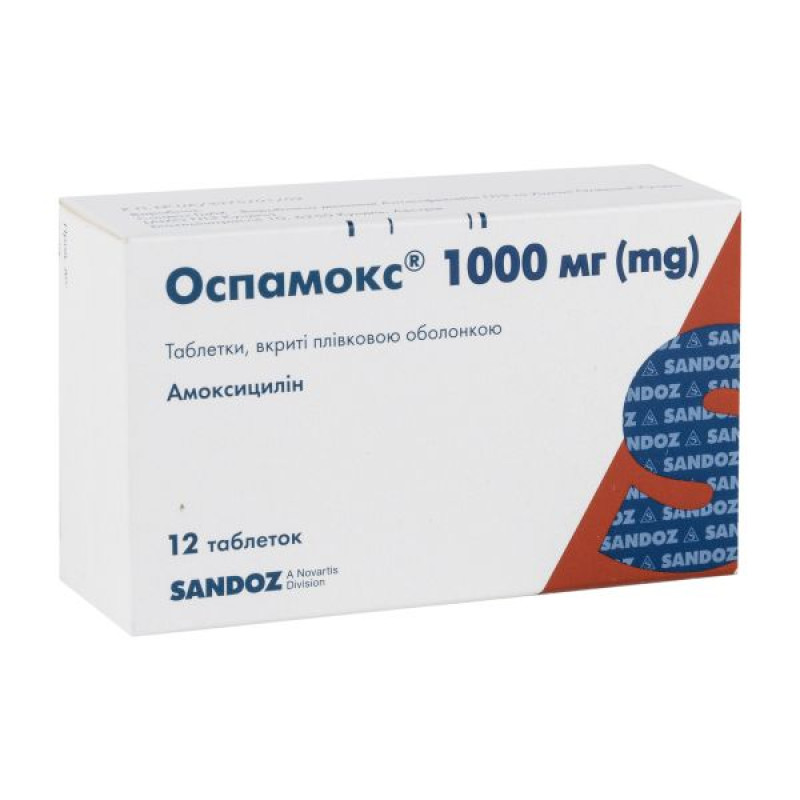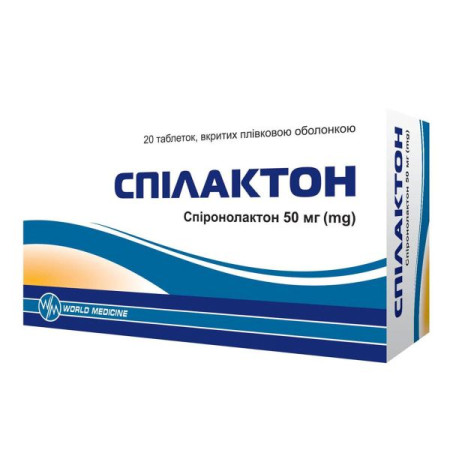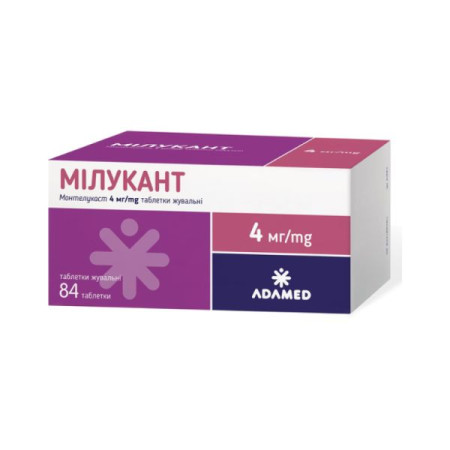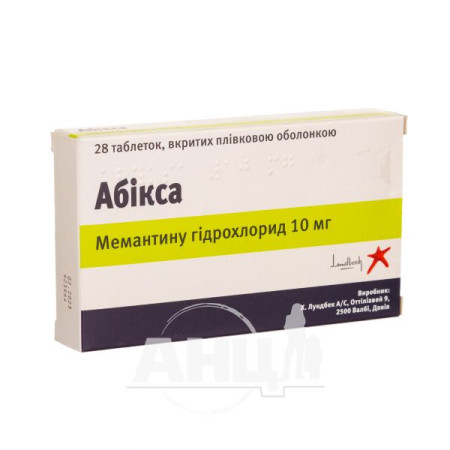Ospamox film-coated tablets 1000 mg No. 12

Instructions for Ospamox film-coated tablets 1000 mg No. 12
Composition
active ingredient: amoxicillin;
1 tablet contains 500 mg or 1000 mg of amoxicillin in the form of amoxicillin trihydrate;
excipients: magnesium stearate, povidone (K 25), sodium starch glycolate (type A), microcrystalline cellulose; coating: titanium dioxide (E 171), talc, hypromellose.
Dosage form
Film-coated tablets.
Main physicochemical properties: oval, biconvex tablets with a score on both sides, white to almost white in color.
Pharmacotherapeutic group
Antimicrobials for systemic use. Beta-lactam antibiotics. Broad-spectrum penicillins. Amoxicillin. ATX code J01C A04.
Pharmacological properties
Pharmacodynamics
Amoxicillin is a semi-synthetic aminopenicillin antibiotic of broad spectrum of action for oral use. It inhibits the synthesis of the bacterial cell wall. It has a broad spectrum of antimicrobial action.
The following types of microorganisms are sensitive to the drug:
- Gram-positive aerobes: Enterococcus faecalis, Listeria monocytogenes, Streptococcus agalactiae, Streptococcus bovis, Streptococcus pyogenes;
– gram-negative aerobes: Helicobacter pylori;
– anaerobes: Peptostreptococci;
– others: Borrelia.
Intermittently susceptible (acquired resistance may be a problem): Enterococcus faecium, Streptococcus pneumoniae, Streptococcus viridans, Escherichia coli, Haemophilus influenzae, Haemophilus parainfluenzae, Moraxella catarrhalis, Proteus mirabilis, Prevotella, Fusobacterium spp.
Resistant species such as: Staphylococcus aureus, Acinetobacter, Citrobacter, Enterobacter, Klebsiella, Legionella, Morganella morganii, Proteus vulgaris, Providencia, Pseudomonas, Serratia, Bacteroides fragilis, Chlamydia, Mycoplasma, Rickettsia.
Pharmacokinetics
Absorption. The absolute bioavailability of amoxicillin depends on the dose and ranges from 75 to 90%. At doses from 250 mg to 1000 mg, bioavailability (AUC and Cmax parameters) is linearly proportional to the dose. At higher doses, the degree of absorption decreases. Food intake has practically no effect on the absorption of the drug. After taking a single dose of 500 mg, the concentration of amoxicillin in the blood plasma is 6–11 mg/l. The maximum concentration of the active substance in the blood plasma is reached after 1–2 hours.
Distribution. Approximately 17% of amoxicillin is bound to plasma proteins. Therapeutic concentrations of the drug are rapidly reached in serum, lungs, bronchial secretions, middle ear fluid, bile, and urine. The concentration of amoxicillin in bile is 2–4 times higher than in blood. Amoxicillin penetrates poorly into the cerebrospinal fluid; however, in inflammation of the meninges (e.g., meningitis), the concentration in the cerebrospinal fluid is approximately 20% of the concentration in plasma.
Metabolism: Amoxicillin is partially metabolized, most of its metabolites are inactive.
Excretion. Amoxicillin is excreted mainly by the kidneys. Approximately 60–80% of the administered dose is eliminated unchanged within 6 hours. The half-life of amoxicillin is 1–1.5 hours. In cases of impaired renal function, the half-life of amoxicillin increases and reaches 8.5 hours in anuria.
The half-life of amoxicillin is not altered by impaired liver function.
Indication
Infections caused by microorganisms sensitive to the drug:
– respiratory tract;
– genitourinary system;
– digestive tract (including eradication of Helicobacter pylori in patients with ulcers
stomach or duodenum, as part of combination therapy);
– skin and soft tissues.
When using amoxicillin as part of combination therapy for the eradication of Helicobacter pylori, information about other medicinal products used in combination therapy should be taken into account.
Contraindication
Hypersensitivity to amoxicillin, to other penicillins or to any of the excipients of the medicinal product. History of severe hypersensitivity reactions (including anaphylaxis) to beta-lactam antibiotics (including cephalosporins, carbapenems or monobactams).
Interaction with other medicinal products and other types of interactions
Probenecid, phenylbutazone, oxyphenbutazone, and to a lesser extent acetylsalicylic acid and sulfinpyrazone reduce the renal tubular secretion of amoxicillin, which may lead to an increase in its plasma levels and prolongation of action. Concomitant use with amoxicillin is not recommended.
Allopurinol. Simultaneous use with amoxicillin contributes to the occurrence of skin allergic reactions.
Tetracyclines. Tetracyclines and other drugs that have a bacteriostatic effect (tetracycline antibiotics, macrolides, chloramphenicol) can neutralize the bactericidal effect of amoxicillin.
Parallel use of aminoglycosides is possible (synergistic effect).
Methotrexate. The use of amoxicillin with methotrexate leads to an increase in the toxic effect of the latter. Amoxicillin reduces the renal clearance of methotrexate, therefore its serum concentration should be monitored.
Other types of interactions.
Elevated levels of amoxicillin in blood plasma and urine may interfere with the results of some laboratory tests. False-positive results are commonly observed with chemical methods.
When testing for the presence of glucose in urine, it is recommended to use the enzymatic glucose oxidase method.
The presence of amoxicillin may affect the results of estriol quantification in pregnant women.
Application features
Hypersensitivity: Before initiating treatment with amoxicillin, careful inquiry should be made regarding previous hypersensitivity reactions to penicillins, cephalosporins or other beta-lactam antibacterial agents and allergens.
Serious and sometimes fatal cases of hypersensitivity (including anaphylactoid reactions and severe cutaneous adverse reactions) have been reported in patients receiving penicillin therapy. Such reactions are more likely to occur in patients with a history of hypersensitivity to penicillins or hypersensitivity to various allergens. If an allergic reaction occurs, amoxicillin therapy should be discontinued and appropriate treatment instituted.
Non-susceptible organisms: Since amoxicillin is not indicated for the treatment of certain types of infections, the drug should be used only when the pathogenic microorganism is identified or when there is reason to believe that the infectious agent is likely to be susceptible to amoxicillin (see section 5.1). This is especially true in patients with genitourinary tract infections and severe ENT infections.
Convulsions: Convulsions may occur in patients with impaired renal function, as well as in those taking high doses of the drug or with a corresponding predisposition (for example, in case of a history of epileptic seizures, treated epilepsy, meningitis - see the section "Adverse reactions").
Renal impairment: For patients with renal impairment, the dose of amoxicillin should be adjusted depending on the degree of renal impairment.
Skin reactions. The appearance at the beginning of treatment of generalized erythema with fever associated with pustules may be a symptom of acute generalized exanthematous pustulosis. Very rarely, Stevens-Johnson syndrome, toxic epidermal necrolysis, Lyell's syndrome, drug reaction with eosinophilia and systemic symptoms (DRESS syndrome) may occur. In such cases, treatment should be discontinued and further use of amoxicillin is contraindicated.
Amoxicillin should be avoided in suspected infectious mononucleosis, as the occurrence of a crust-like rash in this case may be associated with hypersensitivity to penicillins.
Jarisch-Herxheimer reaction. It should be noted that when treating Lyme disease with amoxicillin, the Jarisch-Herxheimer reaction may occur (see the section "Adverse reactions"), which occurs as a result of the bactericidal effect of amoxicillin on the causative agent of Lyme disease - the spirochete Borrelia burgdorferi.
Resistance: Prolonged use of the drug may sometimes cause overgrowth of insensitive microflora. As with other broad-spectrum penicillins, superinfections may occur.
Pseudomembranous colitis. Antibiotic-associated colitis, ranging in severity from mild to life-threatening, has been reported with virtually all antibacterial agents, including amoxicillin. If severe diarrhea consistent with pseudomembranous colitis occurs, discontinuation of the drug and appropriate management are recommended. Antiperistaltic agents are contraindicated.
Necessary measures should also be taken in the event of hemorrhagic colitis or hypersensitivity reactions.
Long-term therapy: During long-term treatment, it is recommended to periodically evaluate the functions of body systems, including the renal, hepatic and hematopoietic systems. Elevated liver enzymes and changes in blood parameters have been reported.
Anticoagulants: Prolongation of prothrombin time has been reported very rarely in patients receiving amoxicillin. When co-administered with anticoagulants, appropriate monitoring should be carried out and the dose of the latter adjusted if necessary.
Crystalluria. Crystalluria has been observed very rarely in patients with reduced diuresis. When using high doses of the drug, it is necessary to drink a sufficient amount of fluid to prevent crystalluria, which can be caused by amoxicillin. The presence of high concentrations of amoxicillin in the urine may cause precipitation in the urinary catheter, so it should be visually checked at regular intervals.
Precautions for premature infants and newborns: kidney, liver and blood function should be monitored.
When using amoxicillin as part of combination therapy for the eradication of Helicobacter pylori, the instructions for medical use of other medicines for combination therapy should be consulted.
Use during pregnancy or breastfeeding
Amoxicillin crosses the placental barrier; its concentration in the fetal plasma is approximately 25-30% of the concentration in the maternal plasma. Limited data on the use of amoxicillin during pregnancy indicate no adverse effects on the fetus/newborn. Animal studies have shown no teratogenic effects of amoxicillin. If it is necessary to prescribe amoxicillin during pregnancy, a careful assessment of the potential risk to the fetus and the expected benefit to the woman should be made.
Amoxicillin is excreted in small amounts in breast milk, so the risk of hypersensitivity in the child during breastfeeding cannot be excluded. The use of the drug during this period is possible only if the expected benefit to the woman outweighs the potential risk to the child. Breastfeeding should be discontinued if the newborn develops gastrointestinal disorders (diarrhea, candidiasis or skin rashes).
Fertility: There are no data on the effect of amoxicillin on fertility in humans. In animal reproductive toxicity studies, no effect on fertility was observed.
Ability to influence reaction speed when driving vehicles or other mechanisms
Until the individual reaction to the drug is determined (dizziness, convulsions may occur), it is recommended to exercise caution when driving or operating other machinery.
Method of administration and doses
The dose of amoxicillin is determined by the doctor depending on the age, body weight and kidney condition of the patient, as well as the sensitivity of microorganisms and the localization of the infectious process.
Food intake does not affect the absorption of amoxicillin. The tablet should be swallowed whole or divided into parts, not chewed, washed down with 1 glass of water.
Dosage. In case of mild to moderate infectious and inflammatory diseases, adults and children over 12 years of age (with a body weight of more than 40 kg) are recommended to take 500–750 mg 2 times a day or 500 mg 3 times a day.
When treating chronic diseases, in case of relapse, severe infection, the dose of the drug can be increased and it is recommended to divide it into 3 doses: adults are prescribed 750–1000 mg 3 times a day; children over 12 years old - up to 60 mg/kg/day in 3 doses.
Children with a body weight < 40 kg.
The daily dose for children is 40–90 mg/kg/day, divided into 2–3 doses (do not exceed 3 g/day), depending on the indications, severity of the disease, and sensitivity of microorganisms.
Pharmacokinetic and pharmacodynamic data indicate that the use of the drug three times a day is more effective than twice a day (it is recommended to divide the daily dose of the drug into 2 doses if it is close to the upper recommended limit).
Special recommendations.
Tonsillitis: 50 mg/kg/day in 2 divided doses.
Acute otitis media: in areas with high prevalence of penicillin-susceptible pneumococci, the dosage regimen should be in accordance with national/local recommendations.
Early stage Lyme disease (erythema migrans): 50 mg/kg/day in 3 divided doses for 14–21 days.
Prophylaxis of endocarditis: adults – a single dose of 2–3 g of amoxicillin 1 hour before a planned surgical procedure; children – a single dose of 50 mg/kg of body weight 1 hour before a planned surgical procedure.
Gonorrhea (acute, uncomplicated): take a single dose of 3 g.
Duration of use. In case of mild and moderate infections, the drug is taken for 5-7 days. However, if the infections are caused by streptococcus, the duration of treatment should be at least 10 days.
When treating chronic diseases, local infectious lesions, and severe infections, the duration of treatment is determined by the clinical picture of the disease.
The drug should be continued for 48 hours after the symptoms of the disease disappear.
Patients with renal impairment.
It is necessary to reduce the dose of the drug in patients with severe renal insufficiency.
For patients with creatinine clearance below 30 ml/min, it is recommended to increase the interval between taking the drug and reduce the daily dose of the drug. In case of impaired renal function, short courses of treatment (taking a single dose of 3 g) are not recommended.
Table 1
Renal failure in adult patients (including elderly patients)
| Creatinine clearance, ml/min | Doses, mg | Application interval |
| > 30 | Does not require dose adjustment | |
| 10–30 | 500 | 12 hours |
| < 10 | 500 | 24 hours |
At the end of the hemodialysis procedure, 500 mg of amoxicillin should be administered.
Table 2
Renal failure in children weighing less than 40 kg
| Creatinine clearance, ml/min | Dose | Application interval |
| > 30 | Usual dose | No need to change |
| 10–30 | Usual dose | 12 hours (corresponding to ⅔ dose) |
| < 10 | Usual dose | 24 hours (corresponding to ⅓ dose) |
Patients with liver dysfunction.
In case of impaired liver function, dosage adjustment is not required.
Children
For children under 12 years of age, another dosage form of the drug is recommended – suspension.
Overdose
Symptoms: digestive tract dysfunction – nausea, vomiting, diarrhea, which may result in a violation of water and electrolyte balance.
Cases of crystalluria, sometimes leading to renal failure, have been reported. Convulsions may occur in patients with impaired renal function or in patients receiving high doses (see sections 4.4 and 4.8).
Treatment: induce vomiting or perform gastric lavage, followed by administration of activated charcoal and an osmotic laxative. Maintain fluid and electrolyte balance. Amoxicillin can be removed from the bloodstream by hemodialysis. No specific antidote is known.
Adverse reactions
The most common adverse reactions are diarrhea, nausea, and skin rashes.
Criteria for assessing the frequency of adverse reactions: common (≥ 1/100, < 1/10), uncommon (≥ 1/1000, < 1/100), rare (≥ 1/10000, < 1/1000), very rare (< 1/10000).
Infections and infestations: uncommon - prolonged or repeated use of the drug may lead to the development of superinfections and overgrowth of non-susceptible microorganisms or yeasts, causing candidiasis of the skin and mucous membranes.
From the blood and lymphatic system: rarely - eosinophilia, hemolytic anemia; very rarely - leukopenia, severe neutropenia, agranulocytosis, thrombocytopenia, pancytopenia, myelosuppression, granulocytopenia, increased bleeding time and prothrombin index. These manifestations are reversible upon discontinuation of treatment.
On the part of the immune system: rarely - severe allergic reactions, including angioedema (Quincke's edema), anaphylaxis, serum sickness, allergic vasculitis, laryngeal edema, anaphylactic shock; unknown - Jarisch-Herxheimer reaction (see section "Special instructions").
On the part of the digestive tract: often - diarrhea, nausea, vomiting, flatulence, soft stools, itching in the anus, loss of appetite, enanthema (especially in the mouth), dry mouth, taste disturbance; rarely - discoloration of the surface of the teeth (especially in children when taking the suspension). Proper oral hygiene procedures can prevent tooth discoloration, since such plaque is mostly removed when brushing the teeth; very rarely - antibiotic-associated colitis (including pseudomembranous and hemorrhagic colitis), intestinal candidiasis, black tongue discoloration. These side effects are usually not severe and disappear either during treatment or immediately after the end of therapy. The occurrence of such effects can be prevented if amoxicillin is taken with food.
From the nervous system: very rarely - hyperkinesia, hyperactivity, dizziness, convulsions (in patients with epilepsy and meningitis, in case of impaired renal function, when using high doses of amoxicillin), aseptic meningitis.
On the part of the hepatobiliary system: very rarely - hepatitis, cholestatic jaundice, moderate and short-term increase in liver enzymes (AST, ALT).
Skin and subcutaneous tissue disorders: common: skin rash, urticaria, pruritus; very rare: erythema multiforme, Stevens-Johnson syndrome, toxic epidermal necrolysis, bullous and exfoliative dermatitis, acute generalized exanthematous pustulosis, Lyell's syndrome, drug reaction with eosinophilia and systemic symptoms (DRESS syndrome).
The sudden onset of urticaria indicates an allergic reaction to amoxicillin and requires immediate discontinuation of therapy.
From the kidneys and urinary system: rarely - acute interstitial nephritis, crystalluria.
Other: rarely - fever.
Expiration date
4 years.
Storage conditions
Store at a temperature not exceeding 25 °C in the original packaging.
Keep out of reach of children.
Packaging
500 mg tablets: 12 tablets in a blister; 1 (12 ´ 1) blister in a cardboard box;
1000 mg tablets: 6 tablets in a blister; 2 (6 ´ 2) blisters in a cardboard box.
Vacation category
According to the recipe.
Producer
Sandoz GmbH - Production site Anti-infectives and Chemical Operations Kundl (AIHO Kundl).
Location of the manufacturer and address of its place of business
Biochemiststrasse 10, 6250 Kundl, Austria.
There are no reviews for this product.
There are no reviews for this product, be the first to leave your review.
No questions about this product, be the first and ask your question.


















